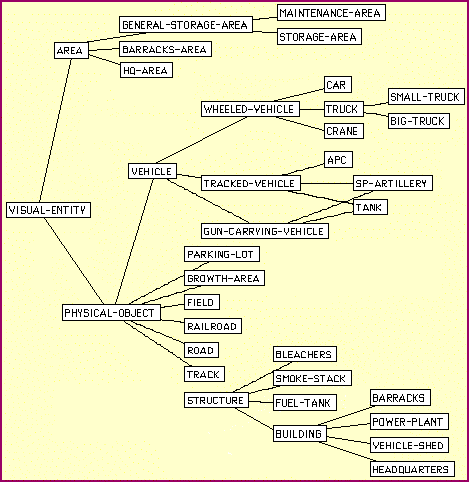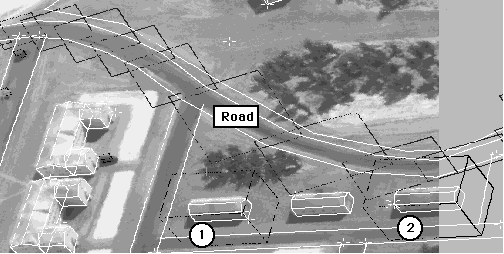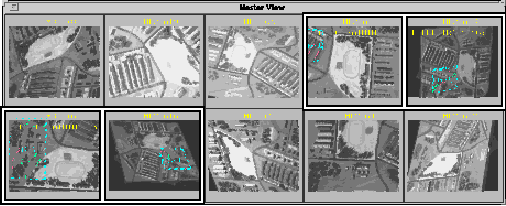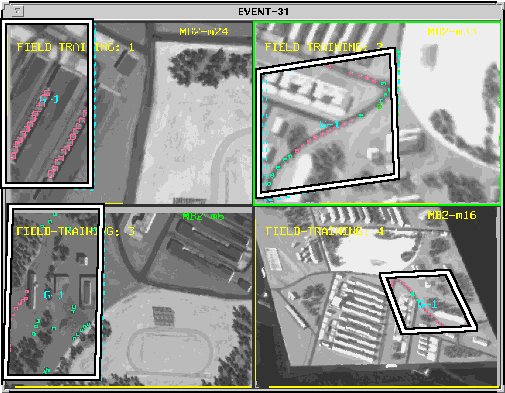VEIL IUW 96
VEIL: Combining Semantic Knowledge with Image Understanding
Thomas A. Russ, Robert M. MacGregor and Behnam Salemi
USC Information Sciences Institute
4676 Admiralty Way
Marina del Rey, CA 90292
{tar|macgregor}@isi.edu [email protected]
Keith Price and Ram Nevatia
USC Institute for Robotics and Intelligent Systems
{price|nevatia}@iris.usc.edu
The VEIL system is pioneering two thrusts within the field of image
understanding that until now have received relatively little attention. First,
VEIL reasons at a semantic level about scene information, using a knowledge
base that augments an original image understanding (IU) model (representing the
output of a lower level IU system) with structural and functional information.
VEIL can apply both spatial and temporal reasoning to detect event sequences
that span multiple images. Second, VEIL provides users with an intelligent
interface that relies on a library of domain-specific terms and queries to
provide a domain-specific browsing and query facility. The library, implemented
in Loom as an extensible ontology of domain specific definitions and queries,
can be easily customized by a user to facilitate analysis activities. [Sponsor]
Table of Contents
- 1 Introduction
- 2 Underlying Technology
- 2.1 RADIUS
- 2.2 Loom
- 2.2.1 Definitions
- 2.2.2 Contexts
- 2.2.3 Query Mechanism
- 3 The Domain Model
- 3.1 Linking the Domain and Site Models
- 3.2 Geometric Relations
- 4 Event Detection
- 4.1 A definition language
- 4.2 Sample event definitions
- 4.3 Example of Event Detection
- 4.4 How it's done
- 5 Current Status
- 6 Future Work
- 7 Conclusion
- References
VEIL performs high level interpretation of scene images using the
deductive capabilities of the Loom knowledge representation system [MacGregor and Bates 1987, Brill 1993],, and provides users with
semantically-enriched browsing and editing capabilities. The VEIL
experiments use a database of RADIUS Model Board 2 image site models
stored in SRI's RCDE system. This database is augmented by a knowledge
base stored in Loom that includes references to the underlying
RCDE-object models, representations of functional and structural
knowledge not contained in the RCDE model, and a library of high-level
spatial reasoning functions. The Loom knowledge base also contains
abstract definitions for objects and events. Using this architecture
as a base, VEIL supports queries that search within an image to
retrieve concrete or abstract objects; or that search across images to
retrieve images that contain specific objects or events. An event in
VEIL is comprised of entities and/or subevents that collectively
satisfy a set of temporal and spatial constraints. VEIL can scan a
sequence of images and detect complex events. In the example
presented in this paper, VEIL finds Field Training Exercise events
consisting of four subevents occurring in distinct images.
VEIL is implemented as a modular architecture wherein all
communication between Loom and the underlying IU system is mediated by
RCDE protocols and data structures [RADIUS
Manual 1993]. In the future, it would be practical for us to
incorporate multiple IU systems into the VEIL architecture. Also, VEIL
could be exported to other sites along with RCDE, allowing other IU
researchers to connect their systems to VEIL. Thus, VEIL provides a
generic means for extending a RCDE-based IU system to include semantic
processing of image data. Use of VEIL also promotes the use of
explicit, declarative domain models. We forecast that this approach
will be a key enabling technology when it becomes time to interconnect
image understanding systems with other knowledge-intensive systems and
applications.
We are extending the semantics of the information that is captured by an image
understanding program by associating domain-level information with images. We
use the following terminology. The image means the digital input data.
For our examples these are photographs. The site model is a geometric
model of objects found in a particular image. Such objects can be roughly
divided into objects representing terrain features, structures and vehicles. A
domain model is a semantic model of items of interest in the domain.
This includes buildings and vehicles as well as abstract notions such as the
function of objects, groups of objects, convoys and field training exercise
events.
Our experiments use the forty RADIUS Model Board 2 images of a hypothetical
armored brigade garrison and exercise area. A site model common to all forty
images was provided by the University of Maryland. This RCDE-object site model
was used with only minor modifications in our work.[1] We augmented the common site model with
vehicle models for a subset of ten images. Vehicles were identified by a
graduate student and their location noted in a file. Vehicle model objects are
needed for VEIL's event processing, but the source of the models is
irrelevant. A suitable automatic vehicle detector could be substituted for our
manual methods.
We use Loom, an AI knowledge representation language in the KL-ONE family, to
provide the infrastructure for semantic reasoning. Loom provides the following
benefits:
- Declarative language. Information is encoded in an easy-to-understand
format. This makes it easy to comprehend and extend the model.
- Well-defined semantics. The meaning of language constructs is
well-defined. The meaning of the terminology is well-established and
validated by over 15 years of AI research into description logics [Brachman 1979, Brachman
et al. 1983].
- Expressivity. Loom is one of the most expressive languages in its class.
- Contexts. Assertions (facts) about multiple images can be
accessed at the same time. This is a key feature used in recognizing
events.
Loom reasons with definitions, which equate a term with a
system-understood description in terms of necessary and sufficient conditions.
This allows useful flexibility in reasoning for a recognition domain. Combined
with a hierarchy of concepts one is able to make assertions that precisely
capture the amount of information available. When details are not known, one
is not forced to overcommit in making entries to the knowledge base. As more
information becomes available it can be added incrementally, improving the
picture of the world. If enough additional information is added, Loom's
classifier automatically recognizes an instance as belonging to a more specific
concept.

Fig.
1. Vehicle Hierarchy of the Domain Model
We will illustrate how this works using the fragment of the domain model
for vehicles shown in Figure 1. Suppose that the first pass of processing is
able to identify some group of pixels in the image as a vehicle. Details about
the type of vehicle are not yet known, so the information is entered as a
"vehicle V1 in location X." With further processing, it may be determined that
the vehicle has tracks. This information can be added, to the knowledge base,
allowing the classification of the vehicle as a tracked vehicle. The
classifier is able to perform this inference because the definition of a
"tracked-vehicle" is a vehicle with a drive type of tracks. Since V1 now
satisfies the definition, Loom automatically concludes that it is of type
Tracked-Vehicle. If an appropriate type of gun is detected, V1 may finally be
recognized as a tank.
By using definitions, Loom can make the inferences licensed by the definitions
automatically. This service frees applications built on top of Loom from
needing to implement their own inference mechanism.
Since Loom's definitions are true equivalences, they can be used to reason in
both directions. The example above illustrated using the components of a
definition to perform a recognition task--synthetic reasoning. One can also
assert the presence of higher level objects and then use the definitions to
identify components that should be present.
For example, a particular SAM unit may be known to deploy with a radar vehicle
and three launchers. If such a unit is asserted to exist in a scene, Loom
concludes that there are three launchers present, even if they are not
identified. The definition can then be used as a guide to what other objects
should be present. It can be used to drive the reasoning. This type of
reasoning was used in another part of the VEIL project that identified runways
[Price et al. 1994].
Loom has a context mechanism that allows one to maintain distinct assertion
sets. Loom's contexts are organized hierarchically, which allows inheritance.
Siblings are separate, so this allows information about different scenes to be
kept separate, but in the same lisp image. The query language (see below) is
able to perform queries across contexts, so one can make comparisons and look
for particular patterns.
Augmenting this flexibility is the fact that Loom contexts are themselves
first-class objects. That means that assertions and annotations about the
context themselves can be represented in the Loom formalism and be used to
select appropriate contexts. This capability was added to Loom version 3.0 in
response to the needs of the VEIL project. For example, if one had a context
associated with a particular image, one could annotate the context with
information such as sun angle, time of day, camera location, etc. This
information is available for image retrieval purposes. At the end of this
paper, we will discuss the use of this context mechanism in event detection..
Event detection will involve searching for a sequence of images (contexts) that
fulfill the criteria for a given event. This uses the ability of Loom to have
several image descriptions in memory simultaneously as well as the ability to
formulate and execute queries that cover several images.
Loom includes a general query facility that is able to find objects based on
their name, type or value of role (relation) fillers.
Queries for Particular Objects: Specific objects can be queried for in
images. Examples include looking for all buildings, all headquarters, all
tanks, etc. These queries allow a seamless use of collateral information in
the RCDE system.
Queries for Relationships: In addition to queries that relate to single
objects, one can also query about relationships. Examples include finding all
buildings with an area of more than 5000 square feet, locating all tanks on
roads, or finding headquarters that are near barracks, etc.
Loom queries are not restricted to single images, but can extend across images.
This type of query is used in the event detection example below.
A prototype knowledge base containing domain concepts was created for use in
VEIL. The type of knowledge encoded in this domain model ranged from the
concrete to the abstract. Loom models for concrete, visible objects such as
roads, buildings and vehicles (see Fig. 2) are linked to geometric objects in
the RCDE site model.

Fig. 2 Domain Model for Visible Objects in VEIL
Collateral information about objects in a scene, such as
"building B44 is a brigade headquarters", is associated with the Loom instance
representing the building. Abstract concepts such as groups, functional roles
and events are used to augment reasoning about the concrete objects.
The main example that we use in VEIL is the concept of a group of vehicles.[2] Abstract entities can be specialized
based on their characteristics. VEIL defines a convoy as a group of vehicles
with at least 65% of them on a road. Additional constraints can be added such
as requiring a minimum number of vehicles (i.e., >4). Loom's flexible
knowledge representation easily supports specialization such as defining a
convoy of tanks.
The definition of a convoy combines information that is present in the Loom
level (such as group membership) with information that is inherently geographic
(such as the location of vehicles on roads). Loom's forte is symbolic
reasoning. Determination of geographic location is geometric reasoning that is
best handled using RCDE model structures. Accordingly, we have developed
several representative and interesting geometric predicates and linked them to
Loom relations. Reasoning is performed at the appropriate level and the
results integrated by Loom.
At the domain model level, the geometric information about the objects is not
directly available. Instead, reasoning is focused on the function and wider
role of the objects. At the geometric level, information about the location
and size of objects is either directly available or computable from directly
available information. For example, the location of a particular cube object
is readily available and its volume can be easily computed using information
stored about the length of the sides of the cube.
We have implemented several functions at the geometric level which are linked
to Loom relations. Table 1 summarizes the basic relations. The most
fundamental predicate is the one that returns locations. Given the three-space
location of objects we implemented directional relations (north, northeast,
etc.), We have also implemented computations for the area and volume of the
most common geometric objects used in the site models.
Loom relations were linked to these functions. This enables Loom queries to
seamlessly exploit both the semantic information contained in Loom's domain
model as well as the geometric information from the underlying site model. An
example of such a composite query is to find "all vehicle storage sheds with a
floor area greater than 5,000 square feet.":
(retrieve ?shed
(and (vehicle-shed ?shed)
(> (area ?shed) 5000)))
The concept vehicle-shed and the relation >
are domain level operators. The relation area is a domain level
relation that is linked to a site model level function.
Geometric relations can also be computed between objects. We implemented a
containment test (contains-point-p), which tests to see if a given three-space
point is contained in a 3 dimensional object (or located over a 2 dimensional
object). This predicate is used in queries and concept definitions to locate
vehicles that are on roads.-- for example in the concepts of vehicles in a
convoy.
One of the more interesting relations that we have investigated is the
"is-near" relation. This is a subjective relation adopted from the nearness
predicate in Abella's Ph.D. thesis [Abella 95]. Her studies found that a
psychologically valid implementation of nearness was influenced by the size of
the objects in question. In other words, the larger the object, the farther
away one could be in absolute distance while still being considered near. She
developed a function that computes an "extended bounding box" for each object,
based on the object's dimensions. When two bounding boxes intersect, the
objects are "near".

Table 1. Geometric Functions and RCDE Objects
We extended her formula to three dimensions. For buildings or
vehicles, this yields appropriate results. The approach breaks down when the
aspect ratio becomes very large. Extremely long, thin objects end up with very
large bounding boxes because of the effect of their length on the size of the
nearness boundary. Roads are a prime examples from the site model that we
use. The length of a road influences how far away one can be from a road and
still be considered near. This produces unintuitive results.
We therefore modified the algorithm for the case of long, thin objects.
Objects with a large aspect ration disregard the long dimension when computing
the nearness boundary. This modification produces appropriate results for our
purposes., Figure 3 shows an image and the associated extended bounding boxes
of a curved road and two buildings. Building 2 (on the right) satisfies the
"near-to" relation with respect to the curved road, but Building 1 (on the
left) does not.[3]

Fig. 3. Extended Bounding Boxes for Computing Nearness
Site model objects have white boundaries.
Extended bounding boxes for selected objects are black.
In this section we describe how we define events -- objects that satisfy
constraints both within and across images. We also outline how VEIL is able to
locate such events in its database.
An event is a sequence of scenes which satisfy certain criteria. Some
of the criteria apply within scenes whereas other criteria describe the
relationship between different scenes. Accordingly, we defined a language that
allows these constraints to be specified in a natural way. The scenes in an
event are described separately, specifying any criteria that apply within a
single scene. A set of global constraints is then used to specify the
conditions that must hold between scenes. The most common cross-scene
constraint is that of order. A sequence of scenes implies that there is an
ordering to the scenes.
Figure 4 shows an event definition named "Field-Training-Exercise" and its
associated Loom query.
(make-event (retrieve (?S1 ?S2 ?S3 ?S4 ?Y)
:name 'field-training-exercise (and (within-context ?S1
:case-roles '((armored-unit ?y)) (In-Garrison ?Y))
:components (within-context ?S2
'((:scene ?s1 ?y (in-garrison ?y)) (Convoy ?Y))
(:scene ?s2 ?y (convoy ?y)) (within-context ?S3
(:scene ?s3 ?y (deployed-unit ?y)) (Deployed-Unit ?Y))
(:scene ?s4 ?y (convoy ?y))) (within-context ?S4
(Convoy ?Y))
:constraints '((before+ ?s1 ?s2) (before+ ?S1 ?S2)
(before+ ?s2 ?s3) (before+ ?S2 ?S3)
(before+ ?s3 ?s4)))) (before+ ?S3 ?S4))
Fig. 4. Event Definition and Corresponding Loom Query
The event consists of four scenes involving an armored
unit "?y". The scenes must include one with ?y "in-garrison", two scenes with
?y in convoy and one with ?y deployed. In addition, the scenes are constrained
temporally by the :constraints field. Translating this into English, we are
looking for a sequence of scenes showing an armored unit in a garrison, then
moving in convoy, then deployed in a training area and finally in convoy again.
A set of images showing this evolution is shown in the example below.
Figure 5 shows a master view of the ten images we used in our experiments. An
example of a field training exercise event is highlighted. Figure 6 shows a
close-up of the field training exercise with the objects participating in the
event highlighted. A colored box is drawn around the group of vehicles in each
image. (In these figures, the box has been enhanced for better black-and-white
viewing).

Fig. 5. Field Training Exercise Event Found in an Image Sequence

Fig. 6. Close-Up View of Field Training Exercise
The Loom query in figure 4 is used to extract those scenes which meet the event
criteria. This involves satisfying the conditions for each individual scene
(such as finding a group that is in a garrison area in a scene) and also
satisfying the cross-scene constraints (such as being in a particular temporal
order). The Loom query for the event shown above is represented as follows:
The result of this query will be a set of tuples. Each tuple consists of the
four scenes (images) and the group that satisfies the query. The display in
the example was created automatically from one such match.
Because of Loom's named definitions, the query for finding events is quite
compact and reasonably readable. This shows the power of having a
domain-specific language: even complex criteria can be expressed in a concise
and natural manner.
The current VEIL model has been tested using ten images from the RADIUS Model
Board 2 image set. It is integrated with the RCDE code and uses the RCDE
graphics interface for user interaction and display purposes. The figures in
this paper are screen shots.
There are several directions for extending our research. One major direction
would be to improve the matching algorithm used to find events. The current
match relies on using Loom's general query mechanism. While this provides
flexibility, the logic-based query language does not take advantage of special
features of the event matching that can be used to increase efficiency. For
example, there is no direct exploitation of the fact that a sequence is being
looked for. Additional enhancements would be to modify the event matching
language to allow inexact matches. This can take the form of partial matches,
matches to key features but with missing elements, or a more general
probabilistic matching scheme.
A sub-problem of the general matching task is associating groups from one image
with those from a different image. (In the current work, such matching is done
by hand). An interim position would be to use a credulous matcher, although
that would need to be refined in order to scale well. The preferred approach
would be to develop a compatibility score for matches between groups in one
image and groups in another image. This score would be based on factors such
as the size of the group, the composition of the group (i.e., with or without
tanks), as well as heuristic reasoning based on other elements that are visible
in an image. With a more sophisticated matcher, a list of candidate image
sequences can be identified and ranked as to the closeness of the match.
Computer support for assigning individual vehicles to groups is another area
for further investigation. The group assignment problem involves identifying a
collection of vehicle that are related in some interesting way. Geometric
proximity is one important consideration, but it is not always he most
important. Consider a convoy driving by a parking lot. Some vehicles in the
convoy will be closer to parked vehicles than to other convoy vehicles, but the
importance of being on the road should be given more weight in the group
assignment process. A semi-automated grouping tool would be a useful addition
to RCDE.
The bulk of work in IU research has been on developing algorithms that operate
at the pixel level and are able to recognize geometric objects. Common
examples are edge detectors, building detectors and vehicle detectors. In our
work, we have been investigating the next stage of image understanding. In
other words, we are concerned with the question of what sort of processing
would we like to have happen once the low-level detectors have finished their
work.
We feel that the next step involves reasoning with the aid of domain
models--models of the world. This raises the level of abstraction of the
interface between the image analyst and the computer system. Instead of
operating at the level of pixels or geometric shapes,one would like to have the
interface operate at a level that has the appropriate semantic content for the
task at hand. This level would allow interaction in terms of headquarters
rather than buildings, convoys rather than isolated vehicles. By raising the
level of interaction, better use of an image analyst's time can be made.
By increasing the level of abstraction and allowing queries at that level, it
becomes easier to select appropriate images for viewing out of a large library.
By raising the level of abstraction, we are also able to describe events that
cover multiple images naturally and locate them efficiently.
[Abella 1995]
Alicia Abella., From Imagery to Salience: Locative
Expressions in Context, Ph.D. thesis, Columbia University, 1995.
[Brachman et al. 1983]
Ronald J. Brachman, Richard E. Fikes, and Hector
J. Levesque, KRYPTON: A functional approach to knowledge representation,
IEEE Computer, 16(10):67-73, 1983. (Revised version reprinted in
Ronald J. Brachman and Hector J. Levesque, editors. Readings in Knowledge
Representation, Morgan Kaufmann Publishers, Inc., Los Altos, CA, 1985.,
pp. 412-429.)
[Brachman 1979]
Ronald J. Brachman, On the Epistemological Status of
Semantic Networks, pages 3-50, 1979. (Reprinted in Ronald J. Brachman
and Hector J. Levesque, editors. Readings in Knowledge Representation,
Morgan Kaufmann Publishers, Inc., Los Altos, CA, 1985. pp. 192-215)
[Brill 1993]
David Brill, Loom Reference Manual, Version 2.0, USC/ISI,
4676 Admiralty Way, Marina del Rey, CA 90292, December 1993.
[MacGregor and Bates 1987]
Robert MacGregor and Raymond Bates, The Loom
knowledge representation language, Technical Report ISI/RS-87-188,
USC/Information Sciences Institute, 1987.
[Price et al. 1994]
Keith Price, Thomas Russ, and Robert MacGregor,
Knowledge representation for computer vision: The VEIL project, ARPA Image
Understanding Workshop, 1994.
[RADIUS Manual 1993]
SRI International and Martin Marietta, RADIUS Common
Development Environment: Programmer's Reference Manual, version 1.0
edition, July 1993.






